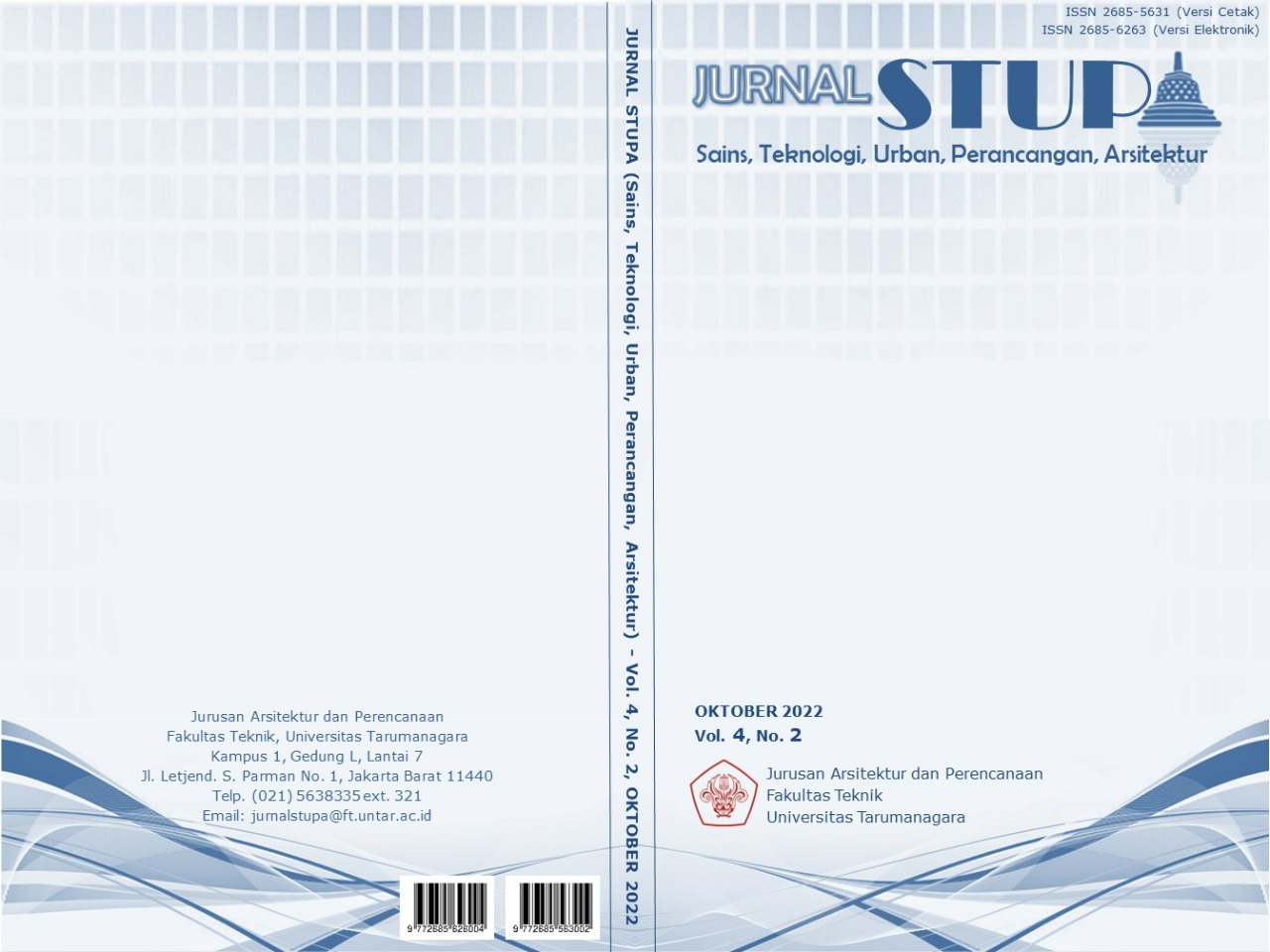REAKTIVASI TAMAN KOTA DENGAN KONSEP INTEGRASI, INFILTRASI, DAN INTERAKSI: KASUS TAMAN KOTA SUMENEP, MENTENG, JAKARTA PUSAT
Main Article Content
Abstract
Urban acupuncture is an architectural approach that aims to smoothen the relationship between an urban space ecosystem and its inhabitants. This approach can trigger people to appreciate the space around them. Generations continue to change over time, resulting in changes in the region's character. Jakarta's rapid development also slowly disappeared from the culture of togetherness and tolerance. Menteng District, Central Jakarta, does not escape this phenomenon. Menteng, an initially proposed garden city, has undeniably developed into one of the luxury areas in Jakarta. However, some disconnected areas still exist in it, namely the green line in the form of a linear park on Jalan Sumenep, Menteng: from the linear park itself, Taman Lawang, ornamental fish market, Latuharhari Busway Stop, Tosari Busway Stop in Jalan Jenderal Sudirman, to Sudirman-Dukuh Atas train station. This area becomes an underused space and limits the potential for interactions and activities. In addition, amid the existence of this luxury area, it still has social disparities between the upper class and the lower classes, even marginalized groups, thus hindering inclusiveness and interaction within the community. Reactivating Sumenep Urban Park, Menteng, Central Jakarta: Integration, Infiltration, and Interaction project aims to revive the underused space in Menteng and become an active area for residents, communities, and visitors.
Keywords: Integration; Menteng Community; Reactivation; Social Gap; Urban Acupuncture
Abstrak
Urban acupuncture merupakan pendekatan arsitektur yang bertujuan untuk melancarkan arus hubungan ekosistem ruang kota dengan penghuninya. Pendekatan ini dapat menjadi pemicu bagi masyarakat untuk menghargai ruang di sekitar mereka. Seiring waktu berjalan, generasi terus berganti dan mengakibatkan perubahan karakter kawasan. Perkembangan kota yang sangat cepat pun menyebabkan budaya kebersamaan serta toleransi terus terkikis. Kecamatan Menteng, Jakarta Pusat, tidak luput dari fenomena ini. Menteng yang dulunya telah direncanakan sebagai kota taman tentu saja berkembang menjadi salah satu kawasan mewah di Jakarta. Meskipun demikian, tetap ditemui koneksi yang terputus di dalamnya, yakni jalur hijau berupa taman linear di Jalan Sumenep, Kelurahan Menteng: dari taman linear itu sendiri, Taman Lawang, pasar ikan hias, Halte Busway Latuharhari, Halte Busway Tosari Jalan Jenderal Sudirman, hingga Stasiun Sudirman-Dukuh Atas. Kawasan ini menjadi suatu underused space yang seolah terpecah dan membatasi potensi interaksi serta aktivitas yang dapat terjadi. Selain itu, di tengah keberadaan kawasan mewah ini masih ditemui kesenjangan sosial antara masyarakat kelas atas dengan kelas bawah, bahkan kelas-kelas tersisihkan, sehingga menghalangi inklusivitas dan interaksi dalam kawasan. Proyek Reaktivasi Taman Kota Sumenep, Menteng, Jakarta Pusat: Integrasi, Infiltrasi, dan Interaksi ini bertujuan untuk menghidupkan kembali underused space di Menteng dan menjadi sebuah wadah aktif bagi warga setempat, komunitas, serta pengunjung yang hadir di dalamnya.
Article Details

This work is licensed under a Creative Commons Attribution-NonCommercial-ShareAlike 4.0 International License.
This work is licensed under a Jurnal Sains, Teknologi, Urban, Perancangan, Arsitektur/ STUPA Creative Commons Attribution-NonCommercial-ShareAlike 4.0 International LicenseReferences
Accordino, J., & Johnson, G. T. (2000). Addressing the Vacant and Abandoned Property Problem. Journal of Urban Affairs, 22(3), 301–315.
Carr, S., Stephen, C., Francis, M., Rivlin, L. G., & Stone, A. M. (1992). Public Space. Cambridge: Cambridge University Press.
de Solà-Morales, M. (2008). Manuel de Solá-Morales: A Matter of Things. Rotterdam: NAi Publishers.
Casagrande, M. (2022). Marco Casagrande Laboratory: Paracity. Urban Acupuncture (OFL Lectures Book 1) [Electronic version]. Rionero in Vulture: Oil Forest League.
Cohen, A. P. (1985). Symbolic Construction of Community (Key Ideas) (1st ed.). London: Routledge.
Greenberg, M., Lowrie, K., Solitare, L., & Duncan, L. (2000). Brownfields, Toads, and the Struggle for Neighborhood Redevelopment: A Case Study of the State of New Jersey. Urban Affairs Review, 35(5), 717–733.
Greenberg, M. R., Popper, F. J., & West, B. M. (1990). The TOADS. Urban Affairs Quarterly, 25(3), 435–454.
Hakim, R. (1987). Unsur Perancangan dalam Arsitektur Lansekap. Jakarta: Bina Aksara.
Heuken, A., & Pamungkas, G. (2001). Menteng: Kota Taman Pertama di Indonesia. Jakarta: Yayasan Cipta Loka Caraka.
Howard, E. (1902). Garden City of Tomorrow. London: Passim.
Larice, M., & Macdonald, E. (2013). The Urban Design Reader (Routledge Urban Reader Series) (2nd ed.). London: Routledge.
Lerner, J. (2016). Urban Acupuncture. Washington, DC: Island Press.
Lynch, K. (1964). The Image of the City. Cambridge: MIT Press.
McMillan, D. W., & Chavis, D. M. (1986). Sense of Community: a Definition and Theory. Journal of Community Psychology, 14(1), 6–23.
Oldenburg, R. (1989). The Great Good Place. Minnesota: Paragon House Publishers.
Pagano, M. A., & Bowman, A. O. M. (2000). Vacant Land in Cities: an Urban Resource (pp. 1-9). Washington, DC: Brookings Institution, Center on Urban and Metropolitan Policy
Perera, L., & Amin, A. (1996). Accommodating the Informal Sector: A Strategy for Urban Environmental Management. Journal of Environmental Management, 46(1), 3–15.
Prijotomo, J. (2008). Pasang Surut Arsitektur Indonesia. Surabaya: Wastu Lanas Grafika.
Project for Public Spaces. (2022). Retrieved July 2, 2022, from www.pps.org.
Simonds, J. O. (1994). Garden Cities 21: Creating a Livable Urban Environment. New York: McGraw-Hill.
Trancik, R. (1986). Finding Lost Space: Theories of Urban Design (1st ed.). New York: Wiley.
Tschumi, B. (1996). Architecture and Disjunction. Cambridge: MIT Press.



